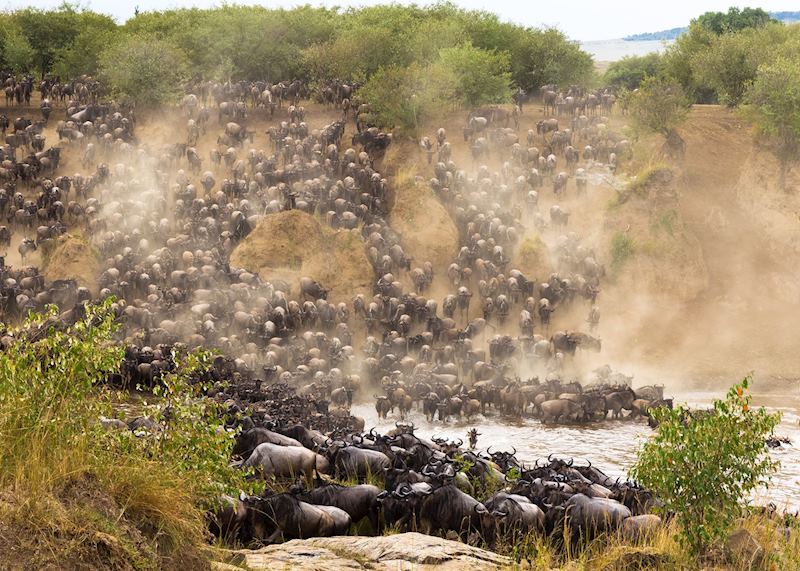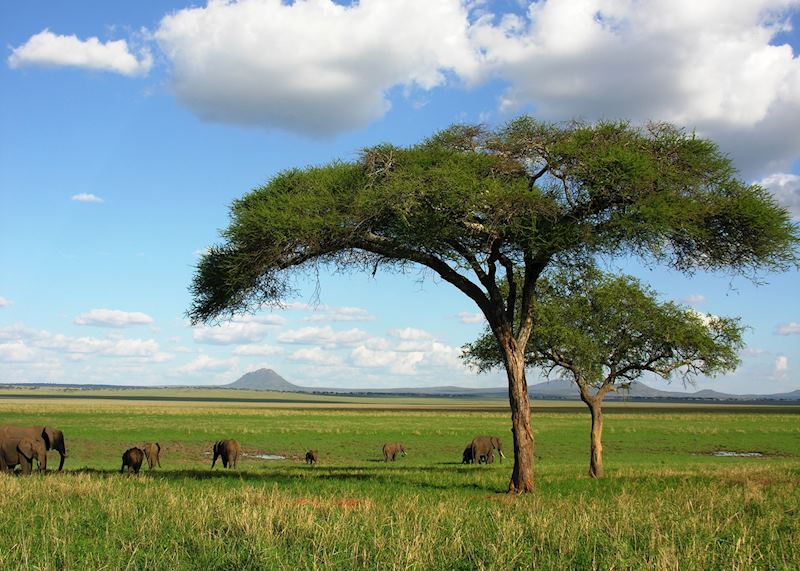By Africa specialist Arista
Witnessing the Great Migration herds thundering toward the Mara River. Connecting with a Maasai community as they share traditional practices with you. Stretching out on palm-fringed shores after long days in the wilderness. There’s a reason Kenya and Tanzania are two of the most popular safari destinations in Africa. If both call to you, I can help you explore the two in a single trip.
Why combine Kenya & Tanzania?
When most people first think of safari, images of swishing grasslands scattered with lions, elephants, giraffes, and wildebeests come to mind. And there’s perhaps nowhere that encapsulates that image better than the savannas of Kenya and Tanzania.
Sharing a border, the two are easy to combine if you want a longer, more in-depth safari experience, or if you’d like to explore more of East Africa’s landscapes, cultures, and wildlife without making two separate journeys.
Below, I’ve listed my top four trip ideas for a combined Kenya and Tanzania holiday.

Kenya safari & Zanzibar beach stay
Perhaps the most popular way to combine Kenya and Tanzania is by starting with a safari in Kenya and ending with time on the powdery white sands of Tanzania’s Zanzibar Island. Kenya does have its own stretch of coast, but there’s much more to do and see on Zanzibar, meaning you can stay a little longer.
When you land in Nairobi, you might be tempted to head straight for Kenya’s best-known safari park, the Masai Mara, but I like to go north to Ol Pejeta Conservancy first. It lies beneath the watchful eye of Mount Kenya, Africa’s second tallest mountain, and is the only place in the world where you can see northern white rhinos. You can also spot reticulated giraffes, Grévy's zebras, and gerenuk antelopes on drives, giving you a wildlife-packed start to your trip.
Then, it’s on to the Masai Mara, known for its huge big cat population (and, depending on what time of year you go, the Great Migration herds). Lions, cheetahs, and leopards roam its wide-open plains, as well as elephants, buffaloes, rhinos, and a host of other classic safari characters. The national reserve itself can be very busy, so I suggest staying in a neighboring private conservancy, like Naboisho, where you can spot all the same wildlife, just with far fewer vehicles around.
When your safari adventure draws to a close, getting between the Masai Mara and Zanzibar Island is speedy enough that you could be scouring the plains for wildlife in the morning and sipping cocktails on the beach in the evening. My preferred place to stay is Breezes Beach Club and Spa, set amid bone-white sands and swooshing palms. For a more intimate stay along the same beach, Breeze’s sister resort, Baraza, has just 30 Swahili-inspired villas.
The island’s aquamarine waters offer plenty of opportunities for snorkeling and diving among fish-filled corals. I also like taking in the views at sunset on a traditional dhow sailing boat. Further inland, you could join a guided forest walk to look for endemic red colobus monkeys, explore Stone Town’s maze of mosques, markets, and forts with a guide, or visit a fragrant spice farm where you can taste fresh cinnamon, ginger, nutmeg, and vanilla.

Masai Mara & Serengeti: the Great Migration from both sides
Over two million wildebeests, zebras, and antelopes migrate between the Masai Mara and the Serengeti throughout the year, following the rains in search of food. Most of the time, they’re in the Serengeti, but from July to October, they cross back and forth between the two regions. It’s at this time of year you have a chance to see the migration from both sides, giving you more opportunities to witness key moments throughout the herds’ tumultuous battle for survival.
Going in September or October will give you the best chance to see them in each park, but it’s worth noting that this is the busiest time to visit the area. If you’re lucky, you might get to witness documentary-worthy drama as the herds crash into the crocodile-infested waters of the Mara River. If not, there’s still plenty to see as they interact, plot their next move, and attempt to evade land predators too.
Karen Blixen Camp is located in the Mara North Conservancy beside a more peaceful section of the Mara River, offering an escape from the crowds of the main reserve. Between Great Migration sightings, you can explore the conservancy’s quieter plains, where lions, wildebeests, hippos, buffaloes, and Masai giraffes are commonly seen.
After a few days here, I can arrange for you to take a light aircraft and a short road trip from the Masai Mara to the Serengeti, a journey that takes just under four hours in total. I recommend staying at Olakira Migration Camp because it moves twice a year to stay as close to the herds (and the perilous river crossings) as possible. After a day of watching the wildebeests approach the Serengeti and spotting other wildlife on drives further afield, you can lie beneath the stargazer section of your tent for unfettered views of the constellations above and the savanna stretching out in front of you.

Kenya & Tanzania in depth
While the Masai Mara and the Serengeti are two of the best-known wildlife regions in the whole of Africa, there’s so much more to see in Kenya and Tanzania. If you have ample time to explore, I could plan a more extensive journey through the countries so you can experience their varied cultures, wildlife, and landscapes.
My first stop after flying into Nairobi would be Lake Nakuru. While lions, giraffes, and rhinos wander along its shores, the draw here isn’t spotting classic safari animals. Instead, a much more flamboyant flock steals the show: flamingos. Hundreds of other bird species have also made their home here, from pelicans to spoonbills and yellow-bellied storks, making it an excellent spot for bird watchers.
Lake Nakuru is just a short light aircraft flight away from the Masai Mara, where you’ll have a chance to spot all the Big Five (lions, elephants, rhinos, buffalos, and leopards). Afterwards, you’ll get to cross more animals off your wish list in the neighboring Serengeti to kick-start the Tanzania portion of your trip.
I find the best way to explore Tanzania is with a driver-guide who stays with you as you go from place to place. You’ll get to know each other well, and they’ll be able to tailor each day to you. Most camps provide shared safari experiences, but, this way, you’ll have a private 4x4 and guide wherever you go, from the golden savannas of the Serengeti to the huge caldera of the Ngorongoro Crater and the elephant-lined riverbanks of Tarangire National Park.
You’ll likely visit — or at least pass by — various Maasai villages during this trip, but for a more immersive experience, end with a stay at Africa Amini Life, near Arusha. Flanked by Mount Meru and Mount Kilimanjaro, the surrounding scenery has an otherworldly feel. It almost looks like lava has bubbled up beneath the grassy mounds.
The retreat is run entirely by Maasai people and you’ll stay in a traditional round house made of earth. While there, you can learn how to throw javelins like a Maasai warrior, take a nature hike with a shaman to find medicinal plants, and make traditional jewelry beneath the shade of an acacia tree. I think it’s the best way to understand the essence of local culture and enjoy a more relaxed few days at the end of your trip.

East Africa explored: the Big Five, gorillas & beach stay
Combining Kenya and Tanzania gives you plenty of opportunities to see Africa’s star-studded cast of animals, but there’s one creature that you won’t see in the continent’s more traditional safari destinations: the mountain gorilla. Though it makes for a lengthy (and very active) trip, if you want to see gorillas and the Big Five in one go, I suggest adding on a few days in Rwanda.
The exact details of this East Africa adventure will depend on your interests. You could start in Kenya’s Masai Mara for a classic safari, before flying to Rwanda to track gorillas deep in the forests of Volcanoes National Park, and then rest up on the shores of Zanzibar. Or there’s a whole myriad of other ways to mix and match the three — I’ll build the route around you.
However you choose to explore Kenya and Tanzania during your trip, your time in Rwanda will center around one thing: the moment you first lay eyes on a wild gorilla. It’s something I’ve been fortunate enough to do myself, and I can honestly say it took my breath away.
After a couple of hours of scrambling through thick foliage and up steep slopes, I turned a corner and there they were: a family huddled on the forest floor, grooming each other, playing, and relaxing in the beams of sunlight that cut through the canopy above. Having been on safari in East Africa many times before, it felt like I was experiencing the region again for the first time. It’s an experience I encourage every wildlife enthusiast to do at some point.

Best time to visit Kenya & Tanzania
When you go to Kenya and Tanzania depends on what you want to see. If you want to experience the Great Migration from both the Masai Mara and the Serengeti, September and October is best, though fairly busy. If you don’t mind short rain showers, go during November and December to see newborn animals with fewer visitors around. The only time I’d advise not going is from March to May, when both countries are very wet.


